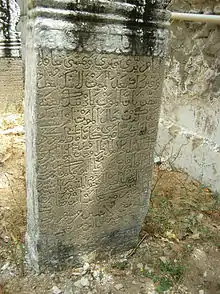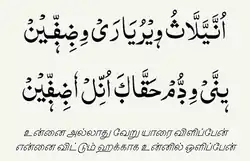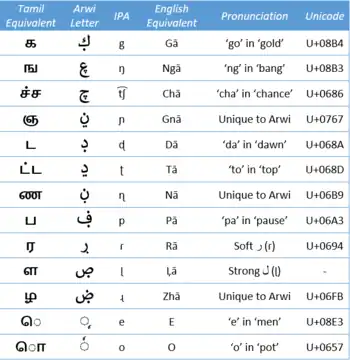| Arwi الْلِسَانُ الْأَرْوِيُّ - அல்லிஸானுல் அற்விய்யு | |
|---|---|
 Arwi written in Arabic Script | |
| Script type | |
Time period | Present |
| Status | Religious Uses |
| Direction | right-to-left script |
| Region | India, Sri Lanka |
| Languages | Tamil |
| Related scripts | |
Parent systems | |
Sister systems | Arabi Malayalam |
| ISO 15924 | |
| ISO 15924 | Arab (160), Arabic |
| Unicode | |
Unicode alias | Arabic |
Arwi or Arabu-Tamil (Arabic: الْلِسَانُ الْأَرْوِيُّ al-lisan al-arwiyy, أَرْوِي arwī;[1] Tamil: அரபுத்தமிழ் arabu-tamil) is an Arabic influenced dialect of the Tamil language written with an extension of the Arabic alphabet, with extensive lexical and phonetic influences from the Arabic language. Arwi was used extensively by the Muslim minority of the Tamil Nadu state of India and Sri Lanka.
History

Arwi was an outcome of the cultural synthesis between seafaring Arabs and Tamil-speaking Muslims of Tamil Nadu. This language was enriched, promoted and developed in Kayalpattinam. It had a rich body of work in jurisprudence, Sufism, law, medicine and sexology, of which little has been preserved. It was used as a bridge language for Tamil Muslims to learn Arabic.[2] The patrons of Arwi seem to have been the Nawab of the Carnatic, they were Islamic and were part of the Mughal Empire. Many hadith manuscripts have been found. Most of the fiqh books, particularly those of Imaam Abu Hanifa and Imaam Shaafi, have been found in Arwi.
There was also a translation of the Bible into Arwi in 1926.
Arwi still has a place among the more Arwi Muslim and Sri Lankan Moor families.
Script


The Arwi alphabet is the Arabic alphabet, with thirteen additional letters used to represent the Tamil vowels e and o and several Tamil consonants that could not be mapped to Arabic sounds.[1]
Vowels
| அ | ஆ | இ | ஈ | உ | ஊ | எ | ஏ | ஐ | ஒ | ஓ | ஔ | |
| اَ | اٰ | اِ / يِ | اِي | اُ | اُو | اࣣ / يࣣ | اࣣي | اَي | اٗ | اٗو | اَو | |
| — | ா | ி | ீ | ு | ூ | ெ | ே | ை | ொ | ோ | ௌ | ் |
| ◌َ | ◌ٰ / ا | ◌ِ | ◌َي | ◌ُ | ◌ُو | ◌ࣣ | ◌ࣣي | ◌َي | ◌ٗ | ◌ٗو | ◌َو | ◌ْ |
| a | ā | i | ī | u | ū | e | ē | ai | o | ō | au | ∅ |
Consonants
|
See also
References
- 1 2 Torsten Tschacher (2001). Islam in Tamilnadu: Varia. (Südasienwissenschaftliche Arbeitsblätter 2.) Halle: Martin-Luther-Universität Halle-Wittenberg. ISBN 3-86010-627-9. (Online versions available on the websites of the university libraries at Heidelberg and Halle: http://archiv.ub.uni-heidelberg.de/savifadok/volltexte/2009/1087/pdf/Tschacher.pdf and http://www.suedasien.uni-halle.de/SAWA/Tschacher.pdf).
- ↑ 216 th year commemoration today: Remembering His Holiness Bukhary Thangal Sunday Observer – January 5, 2003. Online version Archived 2012-10-02 at the Wayback Machine accessed on 2009-08-14
- Shu’ayb, Tayka. Arabic, Arwi and Persian in Sarandib and Tamil Nadu. Madras: Imāmul 'Arūs Trust, 1993.
- Yunush Ahamed Mohamed Sherif ARABUTTAMIL/ARWI: THE IDENTITY OF THE TAMIL MUSLIMS TJPRC Publication.
- Dr. K. M. A. Ahamed Zubair. The Rise and Decline of Arabu–Tamil Language for Tamil Muslims IIUC STUDIES, 2014
- DR. S.M.M Mazahir. அறபுத் தமிழும் அறபுத்தமிழ் ஆக்கங்களும் 2018
External links
- Arwi: Comments, Questions and Answers
- Islamic Cultural Values of Arwi Southeastern university of Sri Lanka. Research and publication (2014).
- For a cultural synthesis Book review in The Hindu
- Arwi or Arabu-Tamil Book on Arwi
- What is Arwi (Arabic Tamil)?
- Arwi (அரபுத்தமிழ் / لسانالأروي)
- 'Arusi branch of the Qadiri path
- Some Arwi Books in Internet Archive